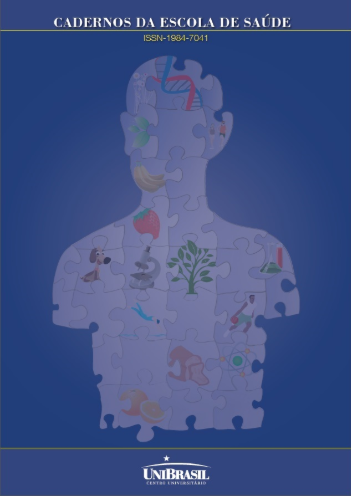A HIPERTERMIA MALIGNA EM PACIENTES EXPOSTOS A ANESTESICOS GERAIS: UMA REVISÃO HIPERTERMIA MALIGNA E OS ANESTÉSICOS GERAIS
Main Article Content
Abstract
Malignant Hyperthermia (MH) is a disorder that causes a disorder in intracellular calcium homeostasis, bringing complications such as muscle stiffness, rhabdomyolysis, and temperatures above 40°C. Dantrolene © in a timely manner. The patient may develop Malignant Hyperthermia when he has genetic susceptibility, associated with exposure to the triggering agents. This study aimed to gather information on the incidence, pathophysiology of the disease, pharmacological triggers, available treatments and clinical and laboratory diagnoses. For this, an integrative review was carried out. Searches were carried out in Pubmed and SciELO databases using the descriptors and their combinations in English maglinant hyperthermia, general anesthesia, using the Boolean operator AND. Articles available in full were selected, from the year 2010 to April 2021. 69 articles were found. After exploratory reading of the title and abstract, 59 articles were excluded. After the complete reading, 7 articles were included in the review. From these articles, information was extracted on prevalence and incidence, pathophysiology, pharmacological triggers, treatment and diagnosis. This study concludes that the lack of knowledge regarding the signs and symptoms, as well as the risk factors, make it difficult to identify cases, resulting in many underreported cases. Therefore, it is extremely important to know the pathophysiology, symptoms of MH and the pharmacological triggers, as this makes it easier to identify a crisis.
Article Details

This work is licensed under a Creative Commons Attribution-NonCommercial-ShareAlike 4.0 International License.
We transfer the copyright pertaining to the manuscript, accepted for publication in this journal, to the exclusive property of Cadernos da Escola de Saúde, and we agree that partial or total reproduction in any means of dissemination, printed or electronic, without the prior and necessary authorization is requested from the Journal's Board of Directors.
References
2. Gomez RS, Silva YP, Peluso CP. Anestesia para cirurgia ortopédica em criança com susceptibilidade à hipertermia maligna. Relato de Caso. Revista Brasileira de Anestesiologia. 2003;53(1):52–7.
3. de Almeida CG, Junior JC. Malignant hyperthermia in a child after magnetic resonance imaging: A case report. Revista Paulista de Pediatria. 2020;38.
4. de Almeida CG, Junior JC. Malignant hyperthermia in a child after magnetic resonance imaging: A case report. Revista Paulista de Pediatria. 2020;38.
5. Rivas Sierra JA, Cardenas Ballarte L, Pérez L, Acosta C, Jiménez L. Hipertemia maligna. Rev cuba pediatr. 1976;48(5):589–95.
6. Das C, Lucia MS HK and TJ. 乳鼠心肌提取 HHS Public Access. Physiology & behavior. 2017;176(3):139–48.
7. Carolina A, Correia DC, Cristina P, Silva B, Araújo B, Acc RC, et al. HM revista SBA. 2012;62.
8. Brunton LL, Chabner BA, Knollmann BC. Farmacológicas da TERAPÊUTICA de G oodman G ilman. 2012. 2079 p.
9. Soares CB, Hoga LA, Peduzzi M, Sangaleti C, Yonekura T, Silva DRAD, et al. Revisão Integrativa versus Revisão Sistemática. Einstein. 2010;8(1):102–6.
10. Urrútia G, Bonfill X. Declaración PRISMA: una propuesta para mejorar la publicación de revisiones sistemáticas y metaanálisis. Medicina Clínica. 2010 Oct;135(11):507–11.
11. Almeida da Silva HC, Ferreira G, Rodrigues G, Santos JM dos, Andrade PV, Hortense A, et al. Profile of malignant hyperthermia susceptibility reports confirmed with muscular contracture test in Brazil. Brazilian Journal of Anesthesiology. 2019;69(2):152–9.
12. Sumitani M, Uchida K, Yasunaga H, Horiguchi H, Kusakabe Y, Matsuda S, et al. Prevalence of malignant hyperthermia and relationship with anesthetics in japan: Data from the diagnosis procedure combination database. Anesthesiology. 2011;114(1):84–90.
13. Almeida da Silva HC, Ferreira G, Rodrigues G, Santos JM dos, Andrade PV, Hortense A, et al. Profile of malignant hyperthermia susceptibility reports confirmed with muscular contracture test in Brazil. Brazilian Journal of Anesthesiology. 2019;69(2):152–9.
14. Yang L, Tautz T, Zhang S, Fomina A, Liu H. The current status of malignant hyperthermia. Journal of Biomedical Research. 2020;34(2):75–85.
15. Cieniewicz A, Trzebicki J, Mayzner-Zawadzka E, Kostera-Pruszczyk A, Owczuk R. Malignant hyperthermia - What do we know in 2019? Anaesthesiology Intensive Therapy. 2019;51(3):169–77.
16. Yang L, Tautz T, Zhang S, Fomina A, Liu H. The current status of malignant hyperthermia. Journal of Biomedical Research. 2020;34(2):75–85.
17. Cieniewicz A, Trzebicki J, Mayzner-Zawadzka E, Kostera-Pruszczyk A, Owczuk R. Malignant hyperthermia - What do we know in 2019? Anaesthesiology Intensive Therapy. 2019;51(3):169–77.
18. Klingler W, Heiderich S, Girard T, Gravino E, Heffron JJA, Johannsen S, et al. Functional and genetic characterization of clinical malignant hyperthermia crises: A multi-centre study. Orphanet Journal of Rare Diseases. 2014;9(1).
19. Hopkins PM. Malignant hyperthermia: Pharmacology of triggering. British Journal of Anaesthesia. 2011;107(1):48–56.
20. Schuster F, Johannsen S, Schneiderbanger D, Roewer N. Evaluation of suspected malignant hyperthermia events during anesthesia. BMC Anesthesiology. 2013;13(1):1.
